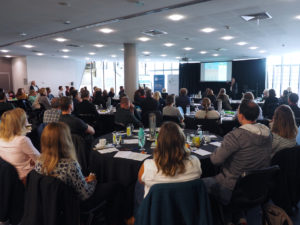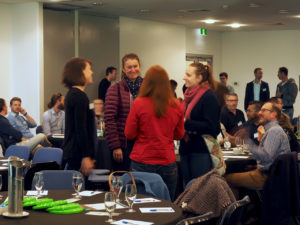Flora and Vegetation in EIA Symposium
Over 120 people attended this two-day event, which aimed to explore the issues surrounding flora and vegetation surveys in Environmental Impact Assessment (EIA) in WA.
It was held over the 21st and 22nd June 2018, in the Ellis Room of the Bendat Stadium in Floreat, Perth.
The President of the ECA Jason Hick and the President of the EIANZ Belinda Bastow officially opened the symposium. This was followed by an eloquent Welcome to Country by Kevin Fitzgerald. The keynote speaker, renowned Western Australian botanist Malcolm Trudgen, told stories of his experiences over the last 45 years working both as a consultant and government botanist across the state.
Day 1…

Day 1 began with a panel discussion consisting of representatives from the Department of Water and Environmental Regulation (DWER), Environmental Protection Authority (EPA) Strategy and Guidance, Department of Mines, Industry Regulation and Safety (DMIRS) and the federal Department of Energy and Environment (DoEE). Discussions included themes such as guidance material, quality and scope of botanical survey reports, indirect impacts, assessment timeframes and associated advice to consult with agencies early. Session 2 covered community involvement in botanical EIA, how EIA is conducted on public lands and the responsibilities that consultant botanists have more broadly in EIA.
Day 1 Session 3 discussed the legal frameworks that govern botanical EIA, including a history of the clearing regulations and updates to the drafting new Biodiversity Conservation Act 2016 regulations. The latter of which, the audience were advised, are due to come into effect on the 1st January 2019. Session 4 eased into more technical discussions, with a specialist flora and vegetation consultant’s view on how to ensure robust technical surveys. This was followed by the EPA’s expectations of botanical survey reports and a discussion by WABSI on how to leverage and aggregate biodiversity data.

Day 2…
Day 2 provided a more technical focus on flora and vegetation surveys. The first session was a practitioners view of how their work operates

within EIA. This included a NSW perspective from our inter-state guest-speaker, and an end-user perspective from a consultant EIA practitioner. Session 2 looked at flora, with an overview of taxonomy going forward followed by some case studies that illustrated how little known our flora still is.
Day 2 Session 3 looked at the challenges there are in classifying and describing our vegetation. Why we do plot based surveys and the science of phytosociology that underpins the methodology. There was a look at Threatened (TEC) and Priority (PEC) Ecological Communities from the Ministerial TEC Scientific Advisory Committee, and the extent to which ecological communities are poorly defined. Session 4 covered allied disciplines, including soils and data management and finishing with a discussion on fungi in EIA.
The symposium was then wrapped up with a group discussion to ensure a synthesis of all the views in the room, followed by a well-attended sundowner event.
Attendees included representatives from all levels of government, consultants from EIA practitioners through to botanical and zoological technicians, community groups, universities and mining companies. Attendees came from as far afield as Karratha, Kalgoorlie and NSW.
This event was joint-hosted by the Environmental Consultants Association (ECA) and the Environmental Institute of Australia and New Zealand (EIANZ). We thank EIANZ for their efforts in making this event a success.
We also thank all the speakers that contributed their time and effort to provide what was thought provoking and engaging content.
Symposium Presentations
Presentations delivered at the Symposium can be viewed below:
- An end user’s perspective on vegetation surveys – Mat Brook [PDF]
- Fungi in EIA – Dr Elaine Davison & Roz Hart [PDF]
- Environmental Protection Act 1986 & Native Vegetation Clearing – Denise True [PDF]
- Environmental law, EIA & the role of environmental consultants – Declan Doherty [PDF]
- A part time taxonomists view of knowledge of the flora of WA & how that affects EIA – Malcolm Trudgen [PDF]
- Community led understanding of Flora & Vegetation Survey – Bronwen Keighery [PDF]
- Threatened Ecological Communities in WA Present & Future – Greg Keighery [PDF]
- A Biodiversity (and Environment) Shared Analytics Partnership for WA- Chris Gentle [PDF]
- Towards meaningful significance assessments for flora and vegetation in EIA- Kelli McCreery [PDF]
- Some personal experiences – Undertaking & Auditing – John Hunter [PDF]
- Vegetation Classification – Who is classifying & what for – John Hunter [PDF]
- Soil Data in WA – narratives to modelling through strategic partnerships- Ted Griffin [PDF]
- Biodiversity Conservation Act 2016 & Regulations Update – Dr Ken Atkins [PDF]
- Vegetation Classification – Lesson’s Learnt from analysing a 30,000 plot database – Sarah Luxton [PDF]
- What to talk about – What has taxonomy ever done for me – Kevin Thiele [PDF]
- Flora and vegetation surveys for EIA…in the real world- Garth Humphreys [PDF]
- Adventures with surveys of WA’s native vegetation for EIA – Malcolm Trudgen [PDF]
- An Age of Discovery – Geoff Cockerton [PDF]
- Biodiversity Conservation Act 2016 – The sharp end of the stick – Melanie Debenham [PDF]
